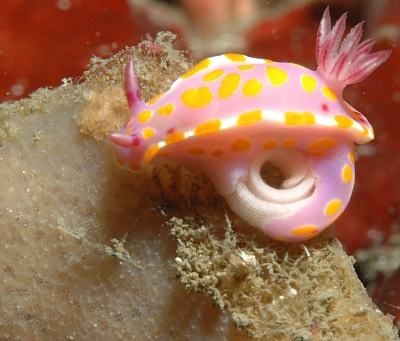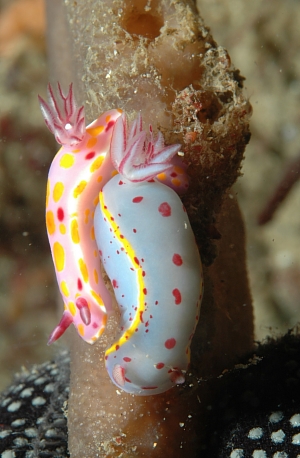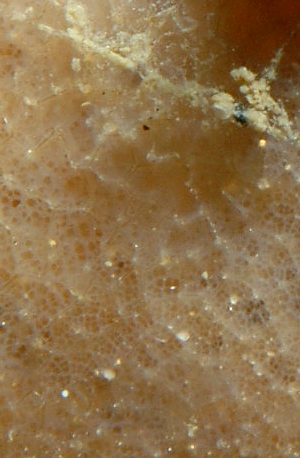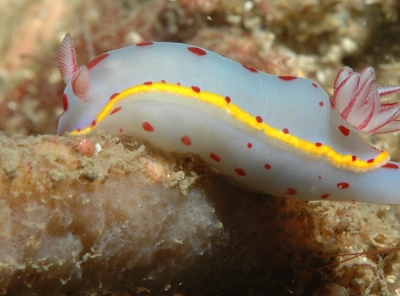Re: Hypselodoris bennetti & Ceratosoma amoena
June 22, 2007
From: Leanne & David Atkinson

Concerning message #19437:
Dear Bill,
Re: message above by Lynda Clarke on Hypselodoris bennetti and Ceratosoma amoena together. We have seen this on a number of occasions at Port Stephens as well. The most recent was on a spade-shaped sponge. There were four nudibranchs on the one sponge, 2 of each type. There were two together on the side and a Ceratosoma amoena laying eggs a bit further down the edge of the wide part of the sponge. Another Hypselodoris bennetti was starting to climb up the stalk. Despite being in 28 metres it was fairly surgey and we needed to hold the sponge to stop it moving and allow focussing. The two that had appeared to be feeding reacted to the sponge being held and moved their heads, hence no positive feeding shots.
Locality: Little Island, east of the mouth of Port Stephens, 28 metres, New South Wales Australia, Pacific, 15 April 2007, Rocky Reef with sponges, ascidians, gorgonias and black coral. Length: approximately 40 mm. Photographer: Leanne & David Atkinson.
Regards,
Leanne & David Atkinson
atk@hunterlink.net.au



Dear Leanne & David,
Thanks for this record - though I am not sure what it is a record of. In Lynda's earlier message the Hypselodoris seems to have its oral tube out, suggesting that it is feeding on the Psammocinia but I don't know whether the Ceratosoma is just 'watching' or eating as well. I think the sponge in your message here is a species of Semitaspongia which is a genus of sponges we often find Ceratosoma amoena feeding on but until now the only feeding records for H. bennetti have been from Psammocinia. So the question here must be is H. bennetti just 'watching'.
Hypselodoris bennetti is a bit of a puzzle because most species of Hyspelodoris feed on sponges of the Dysideidae, while it alone feeds on a species in the Irciniidae. Interestingly, Semitaspongia is in the family Thorectidae and there is one Mediterranean Hypselodoris which feeds on a thorectid, so if H. bennetti also eats Semitaspongia it wouldn't be totally outrageous. I mention all this, not because I want to confuse you, but to show that accurately finding the prey of each species is giving us an interesting insight into relationships.
High resolution photos like this which allow us to see sponge structure are very valuable. It is also useful to include a photo of the sponge colony. But as you note, we need a positive feeding shot, to resolve puzzles like this. Some people have asked me what about studying stomach contents? The problems with chromodorids is that they feed on groups of sponges which lack mineral spicules in their skeletons so there is nothing in the stomach contents to identify. You can certainly find some sponge spicules in chromodorid stomachs from a vast variety of sponge families but that is because the sea floor is littered with stray sponge spicules which are ingested as an animal feeds on its chosen food. Even herbivores have been reported to eat sponges when the presence of such spicules in stomach contents are misinterpreted.
Best wishes,
Bill Rudman
Related messages
-
Re: Hypselodoris bennetti mating
From: Leanne & David Atkinson, February 5, 2008 -
Hypselodoris bennetti & Ceratosoma amoena
From: Lynda Clarke, February 12, 2007 -
Hypselodoris bennetti mating on sponge
From: Sean McMahon, January 21, 2004 -
Hypselodoris bennetti mating
From: Leanne & David Atkinson, January 21, 2004 -
Hypselodoris bennetti - breeding season?
From: Sascha Schulz, January 20, 2004 -
Hypselodoris bennetti feeding
From: Leanne & David Atkinson, January 15, 2004 -
Hypselodoris bennetti from Jervis Bay
From: Sue Newson, September 8, 2003 -
Hypselodoris bennetti from nthn New South Wales
From: David Wachenfeld, June 27, 2002 -
Hypselodoris bennetti from New South Wales
From: Stuart Hutchison, March 10, 2002 -
Hypselodoris bennetti from Sydney
From: Akos Lumnitzer, June 13, 2000 -
Hypselodoris bennetti from Sydney
From: Betsey Hansen, August 9, 1999
